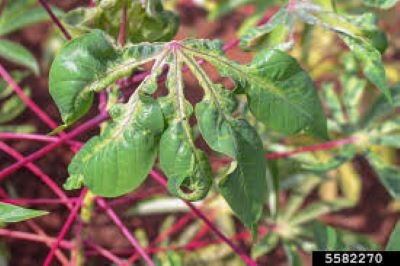Cassava production in western Kenya is being threatened by an army of pests and diseases that could decimate harvests. This starchy crop—the second most important in Kenya’s western and coastal regions, after maize—feeds over 500 million people in sub-Saharan Africa, and the challenge from these threats could have devastating consequences for food security in the region. But, new research offers hope for both farmers and consumers.
In a recent study titled “Occurrence and Distribution of Major Cassava Pests and Diseases in Cultivated Cassava Varieties in Western Kenya,” scientists from IITA and the Kenya Agricultural and Livestock Research Institute (KALRO) conducted field surveys across six major cassava-producing counties to understand how two devastating diseases—Cassava Mosaic Disease (CMD) and Cassava Brown Streak Disease (CBSD)—and pests like whiteflies and cassava green mites (CGM) are affecting cassava production. Their discoveries highlight both the challenges and potential solutions to these “invisible” enemies.
CMD and CBSD are spread by whiteflies—tiny insects that feed on cassava plants. CMD causes yellow, twisted leaves, stunting plant growth, while CBSD—which causes extreme yield loss—results in brown streaks inside the cassava roots, rendering them unmarketable and inedible. These diseases are a major cause of food loss in the region.
The surveys—conducted in 2022 and 2023—revealed that CMD is widespread, but thanks to improved cassava varieties, it is not as rampant as it once was. On average, CMD affected 26.4% of plants in 2022, but improved varieties, like MM96/4271, showed far lower infection rates—only 5.9%. This variety is popular among farmers and is resistant to CMD and tolerant of CBSD, helping protect cassava yields.
One of the scientists, Senior KALRO researcher Vincent Woyengo, was pleased with the widespread adoption of KALRO-promoted improved varieties. He said, “KALRO improved varieties are tolerant to the effects of the major cassava virus diseases as well as being high yielding and adapted to environments in western Kenya. However, KALRO is keen to build on improved variety adoption by strengthening seed delivery systems, improving marketing structures, and training farmers in good agricultural practices.”
However, this multiple-front fight involves more than just disease. Whiteflies are multiplying rapidly, with 28% of surveyed fields in 2023 showing alarming infestations. CGMs are another threat, with their numbers increasing due to unpredictable weather, potentially linked to climate change. These mites feed on young cassava leaves, slowing plant growth and reducing yields.
IITA Vector Entomologist Everlyne Wosula, who led the survey team, emphasized the urgent need to re-establish routine surveillance of plant pests and diseases. She explained: “The reemergence of CGM despite previous biocontrol efforts calls for immediate research to understand the resurgence and to develop effective control measures. This is crucial, as cassava is being championed as a climate-resilient crop for food security, yet it remains vulnerable to pest outbreaks, especially under dry conditions.”
This study highlights these ongoing threats to cassava production in western Kenya, but there is good news. The extensive adoption of improved varieties like MM96/4271 shows promise in reducing the impact of these diseases. Scientists believe they can reduce crop losses and ensure cassava’s future as a reliable food source by developing disease-resistant strains and promoting better seed systems, thereby expanding the adoption of improved varieties, developing IPM strategies, and enhancing cassava’s resilience to both pests and climate-related stressors. Combining these efforts with integrated pest management will further protect cassava against its relentless enemies.
IITA Plant Health Scientist James Legg, who provides oversight for IITA’s cassava pest and disease research in East Africa, was encouraged to see how improved varieties, jointly developed by IITA, KALRO, and Uganda’s National Agricultural Research Organisation (NARO), have been widely adopted by farmers in western Kenya. Legg noted, “Teams of researchers from IITA, KALRO, and NARO put a huge effort into introducing cassava virus-resistant varieties from Uganda to Kenya in the late 1990s. This was when an epidemic of severe CMD was spreading through western Kenya like wildfire. It is wonderful to see now that several of these varieties have been so widely adopted by Kenyan farmers and are helping them to produce abundant food as well as earning extra income.”
The outcomes demonstrated by the new study have far-reaching implications for food security in Kenya and across sub-Saharan Africa, and with climate change adding pressure to African agriculture, safeguarding cassava is more important than ever.
Contributed by Uzoma Agha


